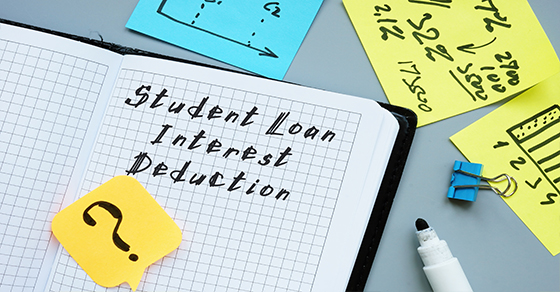

The federal student loan “pause” is coming to an end on August 31 after more than three years. If you have student loan debt, you may wonder whether you can deduct the interest you pay on your tax return. The answer may be yes, subject to certain limits. The deduction is phased out if your adjusted gross income exceeds certain levels — and they aren’t as high as the income levels for many other deductions.
Deduction basics
If you’re eligible, the maximum amount of student loan interest you can deduct each year is $2,500. The interest must be for a “qualified education loan,” which means a debt incurred to pay tuition, room and board, and related expenses to attend a post-high school educational institution, including certain vocational schools. Post-graduate programs may also qualify. For example, an internship or residency program leading to a degree or certificate awarded by an institution of higher education, hospital, or health care facility offering post-graduate training can qualify.
It doesn’t matter when the loan was taken out or whether interest payments made in earlier years on the loan were deductible or not.
It’s not available to everyone
For 2023, the deduction is phased out for single taxpayers with adjusted gross income (AGI) between $75,000 and $90,000 ($155,000 and $185,000 for married couples filing jointly). The deduction is unavailable for single taxpayers with AGI of more than $90,000 ($185,000 for married couples filing jointly).
Married taxpayers must file jointly to claim this deduction.
The deduction is taken “above the line.” In other words, it’s subtracted from gross income to determine AGI. Therefore, it’s available even to taxpayers who don’t itemize deductions.
No deduction is allowed to a taxpayer who can be claimed as a dependent on another tax return. For example, let’s say a parent is paying for the college education of a child whom the parent is claiming as a dependent. In this case, the interest deduction is only available for interest the parent pays on a qualifying loan, not for any of the interest the child may pay on a student loan. The child will be able to deduct interest that’s paid in later years when he or she is no longer a dependent.
More rules
The interest paid must be on funds borrowed to cover qualified education costs of the taxpayer or his or her spouse or dependent. The student must be a degree candidate carrying at least half the normal full-time workload. Also, the education expenses must be paid or incurred within a reasonable time before or after the loan is taken out.
Taxpayers must keep records to verify qualifying expenditures. Documenting a tuition expense isn’t likely to pose a problem. However, care should be taken to document other qualifying education-related expenses including books, equipment, fees, and transportation.
Documenting room and board expenses should be straightforward for students living and dining on campus. Students who live off campus should maintain records of room and board expenses, especially when there are complicating factors such as roommates.
If you’d like help in determining whether you qualify for this deduction or if you have questions, contact us.

